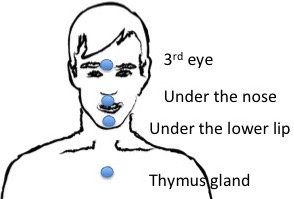

Tapping is an important component that contributes to the effectiveness of the LIMBIC COACHING method. You have probably heard of some of the multiple tapping methods out there.
The best known is EFT (Emotional Freedom Technique by Gary Craig), which originates from TFT (Thought Field Therapy by Roger Callahan), EDxTM (Energy Diagnostic and Treatment Methods by Fred Gallo) and others, such as PEP (Process and Embodiment oriented Psychology by Michael Bohne) in Germany.
The common premise behind all of them is that when tapping specific points on their body while thinking of something stressful, the client’s perceived level of stress can be drastically reduced.
The various tapping methods each have slightly different protocols, but the overall concept is the same:
While thinking of the issue that is causing you stress that very moment, you’re tapping specific points on your body and continue to think of what’s provoking that stress. PEP’s founder Michael Bohne always says it doesn’t really matter which point you’re tapping, as long as you’re tapping when you’re experiencing stressful emotions and preferably stay with the points that resonate best. By tapping these particular points you’re stimulating receptors in the skin that send some calming messages to your brain.
The effectiveness of tapping comes down to the following:
- The client is really focused on something that triggers stress or confronts himself with some difficult situation.
- The stimulation and sense of touch helps releasing the attachment to the block and the emotion connected to that.
- Verbalizing the stressful emotion and including a self-accepting phrase
“puts it out there” and facilitates processing.
LIMBIC COACHING focuses on bilateral brain hemisphere stimulation. The guided eye movements that are part of the protocol accomplish this very well. But I discovered that alternatingly tapping the points on both sides of the body accomplishes even faster results than stimulating points on just one side of the body, like most methods’ protocols suggest.
Nevertheless, LIMBIC COACHING ’s tapping is not limited to points that can be tapped bilaterally. For example, one of our tapping protocols includes 4 points that are extremely powerful. The midline points that Fred Gallo called NAEM (Negative Affect Erasing Method) include the 3rd eye, under the nose, on the chin and on the thalamus gland can’t be tapped bilaterally. However, bilaterally tapping all other points on face, torso and even on the fingers increases their effectiveness.
One of tapping’s great advantages is that it not only facilitates faster emotional resolution during coaching sessions. The client experiences first-hand that there is something that helps them calm down, and they can actually apply this method whenever the need arises.
We always have our body with us, so whenever clients feel stress, blocks or unpleasant emotions they can immediately and effectively address them with tapping. There are even ways of applying it in a subtle, hidden way when around others.
The tapping part of the LIMBIC COACHING protocol is an amalgam of the most effective tapping points from different methods. For instance, I always suggest clients tap the points on both sides of the body alternatingly and with 5 fingers because stimulating the tips of the fingers turned out to be extremely effective.
Another difference of LIMBIC COACHING tapping to other tapping approaches is that we apply a muscle response test to identify what exactly is connected to the client’s issue and then direct the tapping precisely at that.
I keep being impressed how well tapping works. Why not try it for yourself next time you have a strong emotion coming up?
You can start with the 4 NAEM points (the 3rd eye, under the nose, on the chin and on the thalamus gland)


